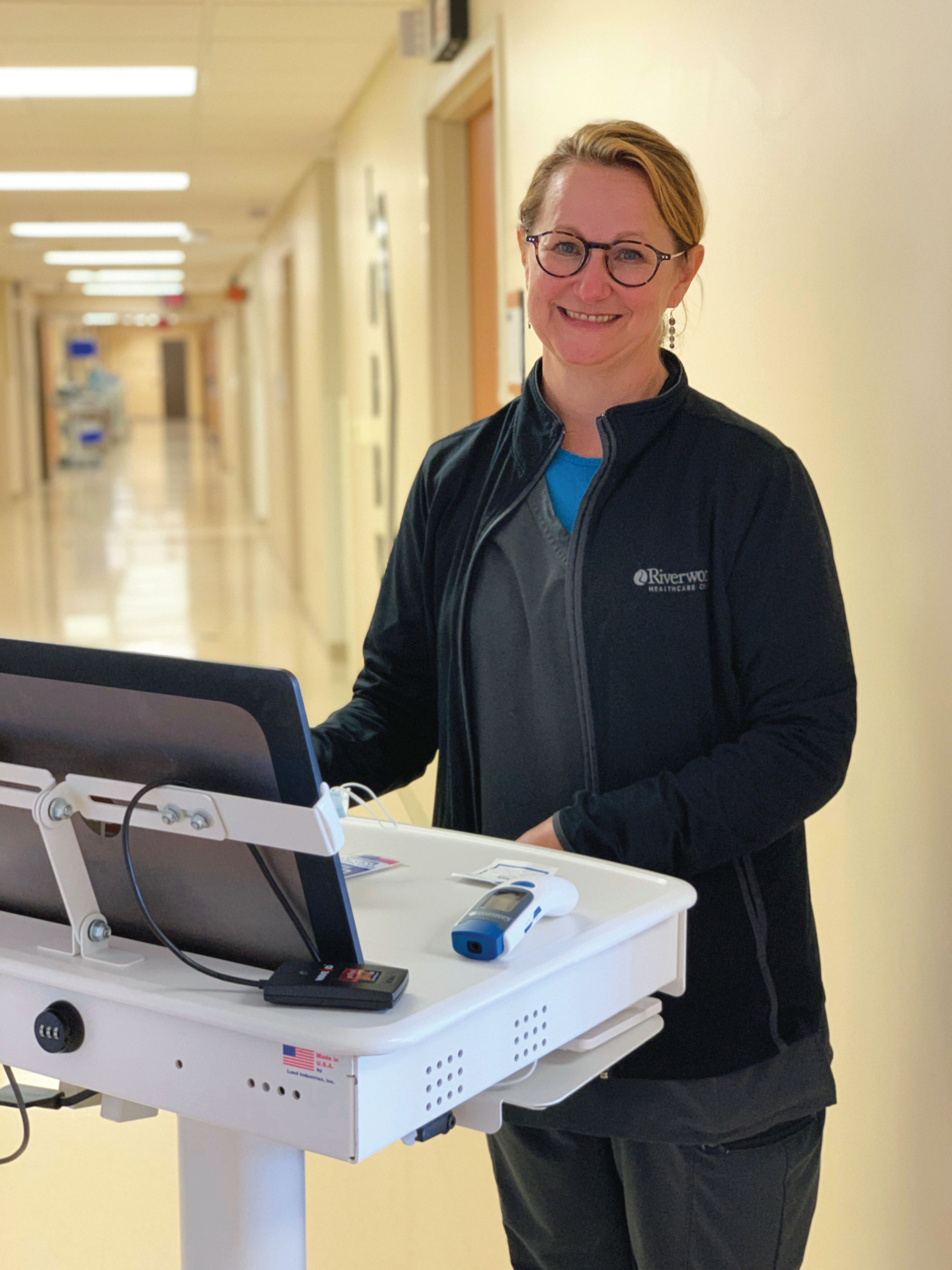Effectively treating a cancer diagnosis requires an immense amount of collaboration. Clinicians are equipped with the clinical knowledge to provide the best care possible, and sharing that crucial information with each other and patients is essential for optimal patient outcomes.

“Communication—verbal and nonverbal—influences my practice every day, from rounding, to in-person meetings, to awareness of what I say on Zoom calls and how I say it,” ONS member Tracy Gosselin, PhD, RN, AOCN®, NEA-BC, FAAN, chief nursing and patient care services officer at Duke University Hospital in Durham, NC, and member of the North Carolina Triangle ONS Chapter, said.
Listening and Keeping Patients Informed Reduces Their Stress
Effective communication improves patient satisfaction and clinical outcomes. Nurses may have all the right skills and tools to provide that information, but sometimes there’s one more hurdle to overcome: the stress that patients experience after a cancer diagnosis.
“We as staff members need to be present mentally, emotionally, and physically so the patient feels heard and so the staff can have proper input for a situation,” ONS member Barb Morris, RN, BSN, OCN®, infusion and radiology supervisor at Riverwood Healthcare Center in Aitkin, MN, and member of the Lake Superior ONS Chapter, said. “A patient might report feeling depressed and if this is not addressed, they may not even hear the education you are providing.”

In a patient’s second treatment cycle, Morris said, her infusion department invites all team members who have an impact on the patient’s care to introduce themselves and educate the patient on the services they provide.
“The goal of this meeting is so the patient can meet the team that is there to help them,” she said.
Using visual aids and updating medical care plans on a daily basis are simple yet effective ways to improve communication with patients. More than 90% of patients reported that bedside whiteboards were helpful and that they frequently read the information on them. Most patients indicated that the names of the team members (95%), current date (87%), upcoming tests or procedures (80%), and goals of care (63%) were most useful to see on whiteboards.
“Take the time to do the right thing for our patients,” Morris said. “Sit with them and listen to what they have to share, and be open to the difficult conversations regarding life, struggles, and death.”
Reminding patients that their concerns are common, routinely asking about their concerns, using active listening, and connecting patients to providers who can address their concerns are all ways to improve patient-centered communication.
“Early on in my career, I quickly learned that my behavior drives another person’s behavior, so remaining calm amid another’s anger related to their disease, side effects, or whatever the situation might be is important,” Gosselin said.
Communication Is Critical for Interprofessional Collaboration
Barriers to interprofessional communication at various levels range from individual (the need for boundaries) to institutional (excessive logistic requirements), and those may be exacerbated by the unique duties of various clinical roles, such as nurse, social worker, or physician.
Gosselin said that poor communication between staff is a safety issue that can lead to failure to escalate care concerns, inability to ask questions for fear of being laughed at or mocke, or not clarifying an order for care.
“Also, if patients and their loved ones overheard or witnessed this type of behavior, think about the impact that would have on them,” Gosselin said.
Find Solutions to Workplace Incivility
Nurses face more workplace violence and abuse than any other profession in the United States. According to the American Nurses Association, 50% of RNs have reported being bullied by a peer, 42% have reported feeling bullied by a person in a higher level of authority, and 24% have reported physical assault from a patient or patient’s family member.
Workplace incivility is a relatively new area of research focus, Gosselin said. Multiple studies looked at the prevalence of miscommunication between nurses, patients, and other clinicians, but not nearly enough have explored how to best address incivility and the skillsets needed for those situations.
“As an executive, I spend time in our nurse residency program talking to new nurses about communication strategies for disruptive patients and family members as well as for how to manage a workplace bully,” Gosselin said. “I share my stories and talk through how I have worked through bullying in my career.”
Gosselin said that having a trusted colleague or mentor to talk through it helps nurses realize that they most likely are not alone. One strategy she learned early on from a mentor was the use of cognitive rehearsal, which is memorizing responses designed to prevent acting impulsively.
“It is important to acknowledge that workplace incivility exists and to then develop a plan on how to move forward,” she said.
Gosselin urged oncology nurses to understand their institution’s policies related to bullying and workplace incivility as well as the work culture on their unit. Then, look for role models who exemplify positive, healthy communication skills.
“Leaders should also be aware that this influences their work culture, employee turnover, and patient care outcomes,” Gosselin said. “Talk with colleagues in your discipline and beyond. A variety of tools and resources exist related to this topic.” She pointed to ANA’s four-part podcast series on workplace incivility.
Being a bystander to bullying has its own impact on the people involved as well as the unit culture. Gosselin encouraged nurses to help the person on the receiving end. The first step might be standing next to the person, then redirecting the conversation or letting the other person know this type of behavior is not acceptable at your institution.
“Nurses have numerous reasons why they may not engage, yet our professional ethics makes it clear that this is not the behavior we want for ourselves, our colleagues, or those we care for,” Gosselin said.
Communication Strategies for Clinicians
Specific interprofessional communication skills are not commonly taught in traditional curricula across healthcare programs, but research and practice have identified various workplace strategies.
Nightly huddles significantly improve nurses’ perception of interprofessional teamwork and communication. Morris found that frequent, in-person meetings fostered communication on her unit and across other departments.
“We try to have monthly meetings to discuss any new processes or changes,” Morris said of her unit staff. “Our facility implemented monthly one-on-one meetings with each member of the team to discuss how they feel everything is going and if they have any ideas for process improvement.”
Morris’s unit educated the radiology schedulers about lab draws, and now her institution has a one-stop shop for the labs, IV fluids, and scans that patients need before their visit with the oncologist. Her institution also created a tool to help the pharmacy and infusion departments communicate directly and instantly through the electronic health record.
“Pharmacy is of the utmost importance when delivering chemo or biotherapy,” she said. “We streamlined the prior authorization process to include pharmacy because we had some challenges in the past when a medication was approved with the insurance company but the biosimilar was not. Now we fax the order to the pharmacy and prior authorization departments and send a secure chat to both. This way the patient does not receive an unexpected bill. They have enough to worry about.”
Other strategies Morris’s institution uses for collaboration include:
- Daily communication between the infusion and oncology clinics, and the two units meet every Tuesday afternoon to discuss their active patients, any questions or concerns, and patients’ specific care requests. “We take notes during the meeting and send them out all oncology and infusion staff,” she said.
- An oncology committee—consisting of a quality coordinator, medical records manager, and infusion staff nurse—that meets monthly to look for improvements and ensure the oncology team is following standards of care
- Institutional policies to flag electronic health records for when patients initiate infusion treatment or need postinfusion precautions so every staff member, from inpatient to emergency department, is informed
“Without communication, we will not provide the quality of care our patients deserve,” Morris said. “Being an oncology nurse has taught me so much about open communication, and I would not change my career for anything.”






